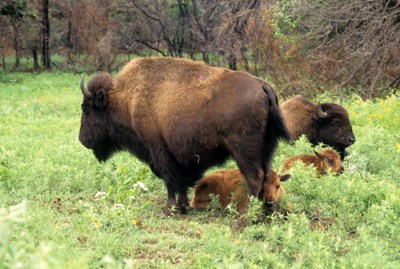Last updated: November 6, 2017
Article
Bison Bellows: Group Dynamics

Photo courtesy of D. Hirschman/US Fish and Wildlife Service.
As the seasons change throughout the year, the size and herd dynamics of the American bison vary. These herd variations are known as seasonal aggregation or seasonal segregation---depending on the time of year. Seasonal aggregation occurs when large, male bison join mixed-age and -sex groups to form larger groups. The biggest aggregations occur during the rut, or the breeding season, when individuals are trying to find mates. In non-rut season, seasonal segregation occurs, when large bulls leave the group to form smaller, separate groups. Seasonal group size is considerably variable as forage conditions, seasonal behavior, population size, landscape composition, and environmental conditions influence group dynamics. In each of these groups, patterns of hierarchical social dominance are also well documented.
Group size increases during the summer breeding season and then rapidly decreases during the fall after the rut. Throughout the year during these non-rut seasons, bison herds vary in structure. Adult females, calves, and immature males will form mixed-age and -sex groups and large bull males will form separate groups. Research infers that males segregate from females because they require more abundant forage due to their large body sizes. They will temporally separate to use the same grasslands as females but at different times.

Photo courtesy of Elise Smith/US Fish and Wildlife Service.
Dominance status in these different groups relates to age and sex. Males are dominant over females, with dominance increasing with age. All male groups exhibit a linear dominance hierarchy, where older and larger males are more dominant over younger and smaller males. Older male bison will become more solitary with increasingly aggressive behaviors. Similar dominance patterns exist with females, as older females will consistently make decisions for the group rather than younger females. It is documented that dominance rank also correlates with body condition, such as weight. An individual's weight at weaning correlates significantly with maternal rank.
During the rut, dominance structures and aggressive behaviors change. Males are dominant over females and older bulls showed more dominant displays of aggression than younger bulls. These increased aggressive behaviors of dominant males may be because bulls with higher social standing have higher breeding rates.
